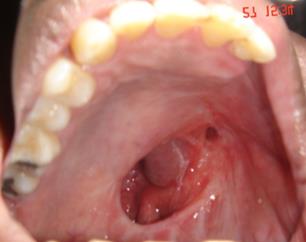Maxillofacial deformities are irregularities or defect in the bones and/or soft tissues of the jaws and face. The most common causes of maxillofacial deformities are trauma resulting from accidents or gunshot wounds, surgical removal of tumors, diseases such as tuberculosis and syphilis and congenital deformities such as cleft palate.
The maxillofacial deformity may affect functional, esthetic and also psychological aspect of the patient. If the defect involves hard palate, speech is hypernasal, and swallow results in nasal regurgitation (food or fluid out of the nose). If the soft palate is involved, fluid or a food bolus cannot be properly propelled into the esophagus, swallow is difficult if not impossible, and speech is hypernasal.
Prosthesis is often needed when surgical reconstruction alone is not possible to close the deformities. The function of the prosthesis includes; to restore esthetic and function, to protect tissues and as a psychological therapy for the patient.
Prosthesis varies in size and shape depending on the extent of the defect. Failure of prosthetic treatment is often related to the retentive properties of the prosthesis which is affected by the number of remaining teeth, defect size, available tissue surrounding the defect and muscular control. There are variety of techniques and type of attachments used to retain the prosthesis, such as implant, magnet and tissue adhesive. Materials which are used in the fabrication of prosthesis are acrylic, silicone and poly-ether rubbers.
There are two types of prosthesis; namely: intraoral and extraoral prosthesis.
- Ocular Prosthesis to replace eye


 Fig 1: Ocular prosthesis
Fig 1: Ocular prosthesis
(source of photo: internet) - Nasal Prosthesis to replace nose.



Fig 2: Nasal prosthesis
(source of photo: internet) - Auricular Prosthesis to replace ear


 Fig 3: Auricular prosthesis
Fig 3: Auricular prosthesis
(source of photo: internet)
Intraoral Prostheses:
- Obturator which covers palate after partial or total loss of maxilla or due to cleft palate. It restores teeth and gums and has an extension which closes the defect or hole for swallowing, eating, chewing, and speaking.

 Fig 4: Obturator
Fig 4: Obturator - Palatal Lift Prosthesis which helps soft palate assume correct position for speech.

Fig 5: Palatal lift prosthesis
(source of photo: internet) - Mandibular Resection Prosthesis to replace portion of the lower jaw that has been lost and restores gums and teeth.

 Fig 6: Mandibular resection prosthesis
Fig 6: Mandibular resection prosthesis
References
- Filiz keyf. Review: Obturator prostheses for hemimaxillectomy patients. Journal of Oral Rehabilitation 2001;28; 821-829.
- General Principles of Maxillofacial Prosthetics . Author: Mounir Kharchaf;
- Harsh M and Sandeep J. Retentive aids in maxillofacial prosthesis. Dental Impact 2012;42.
| Last Reviewed | : | 28 August 2020 |
| Writer | : | Dr. Isma Liza bt. Ali |
| Accreditor | : | Dr. Fauziah bt. Ahmad |
| Reviewer | : | Dr. Roshima bt. Mohd Sharif |







